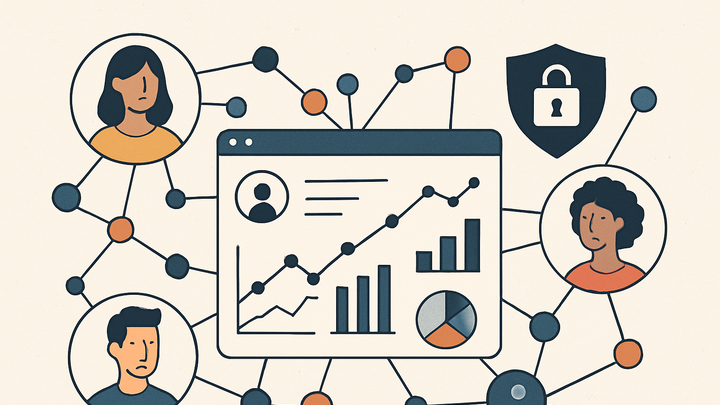Published on 2025-06-28T07:38:02Z
What is User Profiling? Examples of User Profiling in Analytics
User profiling is the process of collecting, analyzing, and organizing data about individual users to build detailed representations of their behaviors, preferences, and attributes. In the analytics industry, this allows businesses to understand user journeys at a granular level, enabling personalization, targeted marketing, and improved customer experiences. With the rise of privacy regulations and changes in browser policies, analytics platforms like PlainSignal offer cookie-free profiling, while tools like Google Analytics 4 (GA4) combine first-party data with modeling to maintain insights. This article explores the mechanisms behind user profiling, implementation examples, and best practices for ethical data handling.
User profiling
User profiling aggregates individual-level data to build detailed user profiles for personalization, segmentation, and analytics.
Introduction to User Profiling
User profiling involves aggregating data from user interactions, demographics, and context to form comprehensive profiles. These profiles help businesses tailor content, improve engagement, and optimize marketing campaigns. Unlike broad audience segmentation, profiling focuses on the individual level, enabling hyper-personalized experiences.
-
Definition
User profiling is the process of collecting and synthesizing individual user data—such as behaviors, preferences, and attributes—into a unified profile that represents a user over time.
-
Purpose
The main goal of profiling is to understand users personally, enabling precise personalization, targeted messaging, and refined analytics insights.
-
Key components
Profiles typically encompass multiple data dimensions:
-
Demographic data
Basic user information like age, gender, and location.
-
Behavioral data
User actions such as page views, clicks, and session duration.
-
Contextual data
Environmental factors like device type, referral source, and time of access.
-
How User Profiling Works in Analytics
Analytics platforms convert raw event data into persistent user identities, enrich those profiles, and update them with new information over time. This section outlines the core stages of profiling pipelines.
-
Data collection
Capture events and metadata via scripts, SDKs, or APIs to record user interactions.
-
Tracking scripts
Code snippets like GA4’s gtag.js or PlainSignal’s script collect events directly in the browser.
-
Sdks & apis
Mobile and server-side integrations extend data capture beyond web.
-
-
Identity resolution
Match identifiers such as cookies, device IDs, or login tokens to maintain consistent profiles.
-
Cookie-based matching
Uses browser cookies to recognize returning users.
-
Login stitching
Links anonymous and authenticated sessions under one user ID.
-
Fingerprinting (limited)
Combines device attributes for identification but is restricted by privacy rules.
-
-
Profile enrichment
Enrich profiles using internal or third-party data and predictive models.
-
Third-party data
Supplemental data acquired through partners or data providers.
-
Machine learning
Algorithms infer preferences, segments, and lifetime value.
-
Approaches to User Profiling
Depending on privacy constraints and technological choices, profiling can be cookie-based or cookie-free. Each approach has trade-offs in accuracy, compliance, and implementation complexity.
-
Cookie-based profiling
Relies on browser cookies to assign and track user identifiers over sessions.
-
Pros
Widely supported and straightforward to implement.
-
Cons
Increasingly blocked by browsers and privacy regulations.
-
-
Cookie-free profiling
Uses first-party data and advanced techniques to profile users without relying on third-party cookies.
-
PlainSignal
A cookie-free analytics platform that focuses on privacy-first profiling via a lightweight script.
-
GA4's approach
Employs first-party cookies and modeling to compensate for data gaps, alongside Google Signals for cross-device profiling.
-
Implementation Examples
Below are code snippets for integrating cookie-free and traditional profiling solutions into your website.
-
PlainSignal integration
Add the following script before the closing </head> tag in your HTML:
-
Code sample
<link rel="preconnect" href="//eu.plainsignal.com/" crossorigin /> <script defer data-do="yourwebsitedomain.com" data-id="0GQV1xmtzQQ" data-api="//eu.plainsignal.com" src="//cdn.plainsignal.com/plainsignal-min.js"></script>
-
-
GA4 integration
Embed the global site tag to collect events and user properties:
-
Code sample
<!-- Global site tag (gtag.js) --> <script async src="https://www.googletagmanager.com/gtag/js?id=GA_MEASUREMENT_ID"></script> <script> window.dataLayer = window.dataLayer || []; function gtag(){dataLayer.push(arguments);} gtag('js', new Date()); gtag('config', 'GA_MEASUREMENT_ID'); </script>
-
Best Practices and Compliance
Ensure that profiling activities respect user privacy and comply with relevant regulations such as GDPR and CCPA.
-
Consent management
Obtain explicit user consent for profiling and offer clear opt-out mechanisms.
-
Data minimization
Collect only essential data and avoid storing unnecessary personal details.
-
Transparency
Clearly disclose profiling practices in your privacy policy and user interfaces.
Use Cases and Benefits
Effective user profiling can drive numerous business outcomes by leveraging enriched user insights.
-
Personalization
Deliver tailored content, product recommendations, and user journeys based on individual profiles.
-
Targeted marketing
Segment users precisely to optimize advertising spend and improve campaign ROI.
-
Churn prediction
Identify at-risk users through behavior patterns and proactively engage them to reduce churn.
